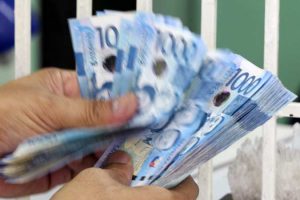
Peso inches up on US PCE report
THE PESO rose against the dollar on Monday as soft US inflation data supported expectations of policy easing by the US Federal Reserve this year.
The local unit closed at P56.27 per dollar on Monday, strengthening by two centavos from its P56.29 finish on Friday, Bankers Association of the Philippines data showed.
The peso opened Monday’s session weaker at P56.40 against the dollar. Its intraday best was at P56.26, while its worst showing was at P56.54 versus the greenback.
Dollars exchanged went down to $1.17 billion on Monday from $1.38 billion on Friday.
“The peso appreciated as the softer-than-expected US PCE (personal consumption expenditures) inflation supported views of Fed policy rate cuts this year,” a trader said in an e-mail.
US prices rose marginally in December, keeping the annual increase in inflation below 3% for a third straight month, bolstering expectations that the Federal Reserve will start cutting interest rates this year, Reuters reported.
The PCE price index increased 0.2% last month after dropping 0.1% in November, the Commerce department’s Bureau of Economic Analysis said. Food prices rose 0.1% and the cost of energy products increased 0.3%
In the 12 months through December, the PCE price index advanced 2.6%, matching November’s gain. The inflation readings were in line with economists’ expectations.
Excluding the volatile food and energy components, the PCE price index climbed 0.2% after rising 0.1% in November. The so-called core PCE price index increased 2.9% year on year, the smallest gain since March 2021, after rising 3.2% in November.
The Fed tracks the PCE price measures for its 2% inflation target. Monthly inflation readings of 0.2% over time are necessary to bring inflation back to target.
The US central bank raised borrowing costs by a cumulative 525 basis points from March 2022 to July 2023 to the 5.25-5.5% range.
The peso was also supported by comments from the Bangko Sentral ng Pilipinas (BSP) chief that stronger gross domestic product (GDP) growth in the fourth quarter of 2023 could give them room to hike rates if needed, Rizal Commercial Banking Corp. Chief Economist Michael L. Ricafort said in a Viber message.
BSP Governor Eli M. Remolona, Jr. said on Friday that they are unlikely to ease their policy stance this semester and remain ready to deliver more rate hikes if needed, especially if data show economic growth picked up in the last quarter of 2023. The BSP hiked borrowing costs by 450 bps from May 2022 to October 2023, bringing the policy rate to a 16-year high of 6.5%.Fourth-quarter and full-year 2023 Philippine GDP data will be released on Wednesday.
For Tuesday, the trader said the peso could weaken anew ahead of the GDP data release. The trader sees the peso moving between P56.15 and P56.40 per dollar, while Mr. Ricafort expects it to range from P56.20 to P56.40. — AMCS with Reuters



